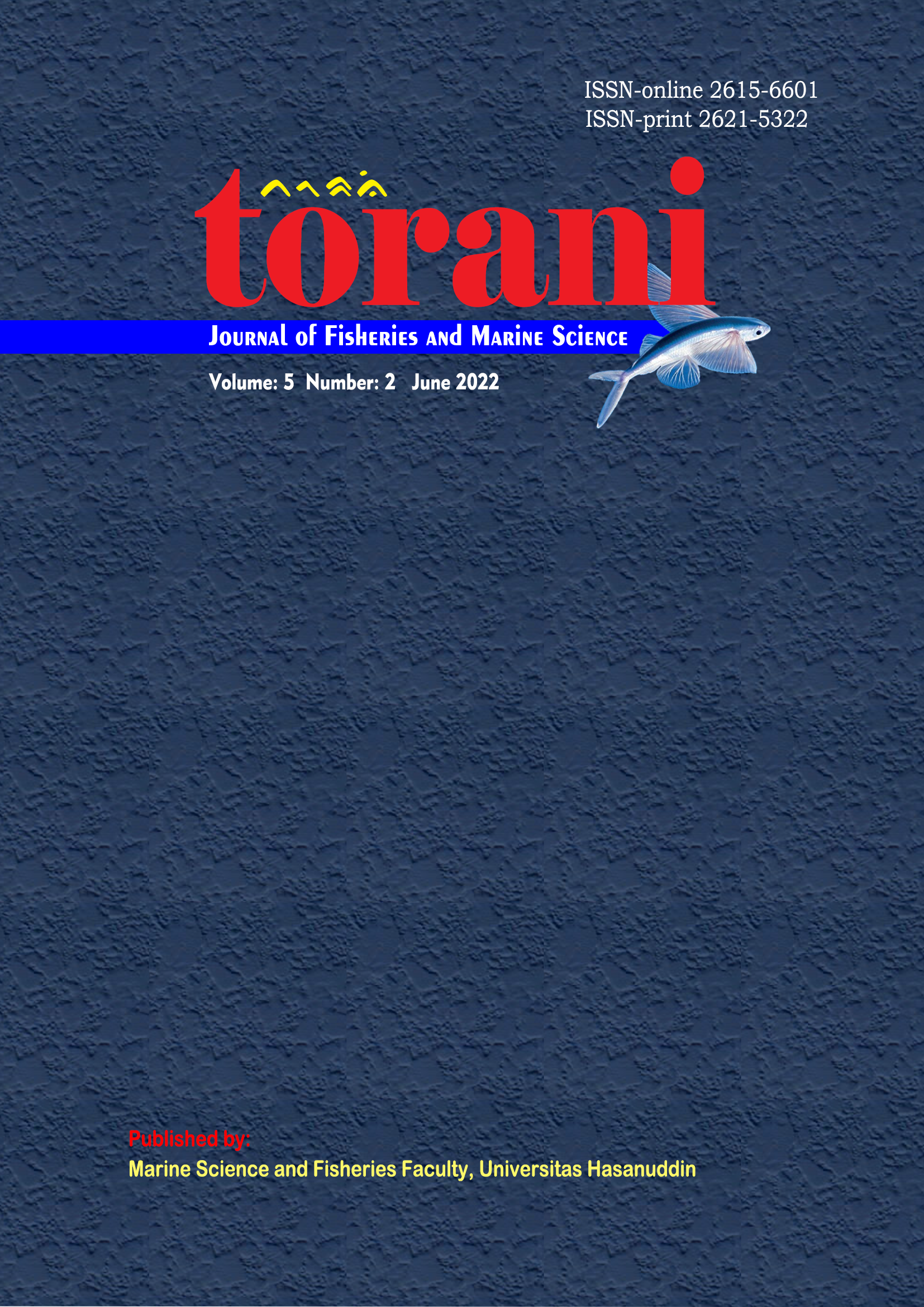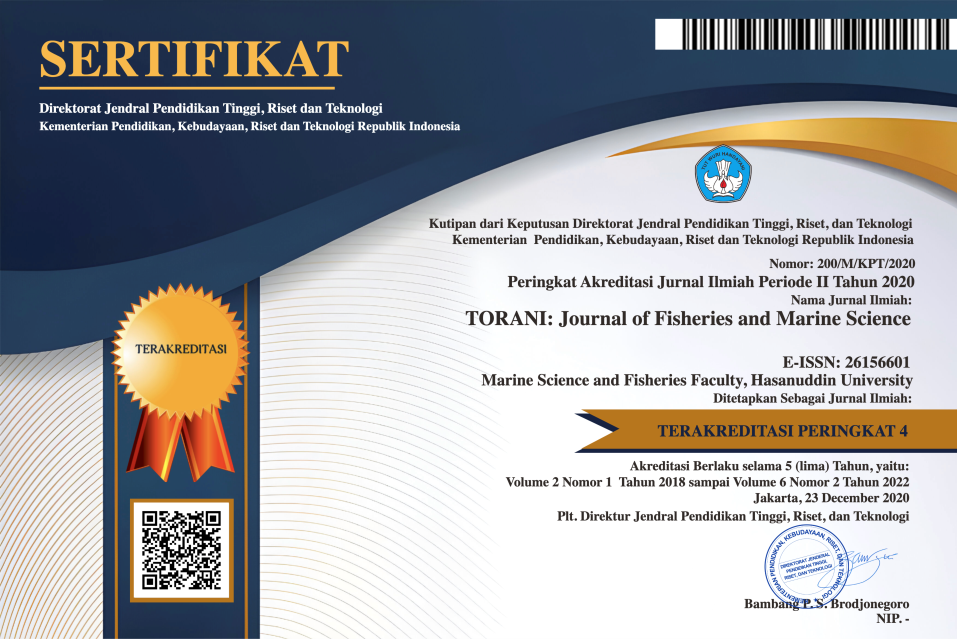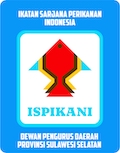Growth Performance of Tilapia Oreochromis niloticus with the Provision of GDM Probiotics maintained with the Biofloc System
DOI:
https://doi.org/10.35911/torani.v5i2.21821Keywords:
biofloc, tilapia, growth, probiotic, survivalAbstract
Tilapia is one type of freshwater fish that has economic value. This type of fish has good adaptability and fast growth. One of the problems in tilapia cultivation is that probiotics have not been utilized in the maintenance media with a biofloc system. This study aimed to determine the dose of probiotic supplementation in the formation of bioflocs on the growth and survival of tilapia. The research was conducted at the Educational Pond, Bosowa University, Maros Regency. The test animals used were tilapia seeds measuring 2-3 cm long. The stocking density of 3 seeds/L were kept in a basin with a capacity of 80 L filled with 60 L of water. The treatment tested was GDM probiotic supplementation in media with doses of A 5%, B 6%, C 7%, and D 0 %. The study used a completely randomized design with 4 treatments and 3 replications so that there were 12 experimental units. Seeds were reared for 60 days by feeding Hi-Pro-Vite FF-99 as much as 3% of body weight biomass per day. The results showed that GDM probiotic supplementation with different doses significantly affected the growth and survival of tilapia. Supplementation of GDM probiotics 5%, 6% and 7% in the media gave the same effect on the growth and survival of tilapia but significantly different from the treatment without probiotics. The highest growth and survival rate of tilapia was obtained at a dose of 5%, 4.27g and 65%, respectively, while the lowest was in the treatment without probiotics, namely 3.27g and 48.33%. Based on the results of the study, it is recommended that 5% GDM probiotic supplementation in tilapia rearing containers is recommended.
References
Agustina, D.T., S. Marnani dan A. Irianto. 2006. Pengaruh Pola Pemberian Probiotik A3 -51 Peroral terhadap Kelangsungan Hidup Bawal Air Tawar (Collosoma macropomum Bry) setelah Di Uji Tantang dengan Bakteri. [Skripsi]. Universitas Jendral Soedirman, 60 hlm.
Aly, SM., Mohamed MF, John G.2008. Effect of probiotics on thesurvival, growth andchallenge infectioninTilapia nilotica (Oreochromis niloticus). Aquaculture Research, 39:647-656
Dharmawan, B. 2007. Usaha Pembuatan Pakan Ikan Konsumsi. Yogyakarta: Pustaka Baru Press. 176 hlm.
Effendie, I. 2002. Pengantar Akuakultur. Penebar Swadaya: Jakarta. hal:188
Fuller, R. 1989. Probiotics in man and animals. J. Appl. Bacteriol. 66: 365-378
Hermawan, TE., Agung Sudaryono, Slamet Budi Prayitno. 2014. Pengaruh Padat Tebar Berbeda Terhadap Pertumbuhan dan Kelulushidupan Benih Lele (Clarias gariepinus) Dalam Media Bioflok,. Journal of Aquaculture Management and Technology Volume 3, Nomor 3, Halaman 35-42.
Iribarren D., Daga, P. Moreira, M.T. and Feijoo, G. 2012. Potential Environmental Effects of Probiotics Used in Aquaculture. Aquaculture int, 779-789 p.
Kordi, K.M.G.H., 2010. Budidaya Ikan Nila di Kolam Terpal. Yogyakarta, Lily Publisher.
Murni. 2004. Pengaruh penambahan bakteri probiotik Bacillus sp. dalam pakan buatan terhadap pencernaan, efisiensi pemanfaatan pakan dan pertumbuhan ikan gurame (Osphronemus gouramy Lacepede) [Tesis]. Program Pascasarjana, Institut Pertanian Bogor. Bogor
Noviana, P., Subandiyono, Pinandoyo. 2014. Pengaruh Pemberian Probiotik dalam Pakan Buatan Terhadap Tingkat Konsumsi Pakan Dan Pertumbuhan Benih Ikan Nila (Oreochromis Niloticus). Journal Of Aquaculture Management and Technology. Volume 3, Nomor 4, Halaman 183-190
Panggabean, T. 2016. Kualitas Air, Kelangsungan Hidup, Pertumbuhan, Dan Efisiensi Pakan Ikan Nila Yang Diberi Pupuk Hayati Cair Pada Air Media Pemeliharaan. Jurnal Akuakultur Rawa Indonesia, 4(1), 67-79.
Praditia, F.P. 2009. Pengaruh Pemberian bakteri Probiotik melalui Pakan terhadap Pertumbuhan dan Kelngsungan Hidup Udang Windu (Paneus Monodon). [Skripsi]. Fakultas Perikanan dan Ilmu Kelautan, Institut Pertanian Bogor, 42 hlm.
Putra AN, Utomo NBP dan Widanarni. 2015. Growth Performance of Tilapia (Oreochromis niloticus) Fed with Probiotic, Prebiotic and Synbiotic in Diet. Pakistan Journal of Nutrition 14 (5): 263-268.
Ramadhana, S.N., F. Arida dan P. Ansyari. 2012. Pemberian Pakan Komersil dengan Penambahan Probiotik yang Mengandung Lactobacillus sp. terhadap Kecernaan dan Pertumbuhan Ikan Nila (Oreochromis niloticus). [Skripsi]. Fakultas Perikanan dan Ilmu Kelautan, Universitas Diponegoro, 184 hlm.
Saopiadi, Amir, S., & Damayanti, A.A. 2012. Frekuensi Pemberian Pakan Optimum Menjelang Panen pada Ikan Nila (Oreochromis niloticus). Jurnal Perikanan Unram. 1(1), 14-21.
Septiarini, E., Harpeni dan Wardiyanto. 2012. Pengaruh Waktu Pemberian Probiotik yang Berbeda terhadap Imun Non- Spesifik Ikan Mas (Cyprinus caprio) Against Aeromonas Salmonicida. e-Jurnal Rekayasa dan Teknologi Budidaya Perairan., 1 (1): 46 hlm.
Setiawati JE, TarsimYT,Adiputra,Siti H.2013. PengaruhPenambahanProbiotik pada PakandenganDosisBerbeda terhadap Pertumbuhan, Kelulushidupan, Efisiensi Pakan dan Retensi ProteinIkan Patin (Pangasius hypophthalmus). Jurnal Rekayasa dan TeknologiPerairan 1(2):151-162
Simanjuntak ICBH, Suminto, Agung S. 2016. Pengaruh Konsentrasi BakteriProbiotik yang Berasosiasi dalam Usus Sebagai Bioflok terhadap EfisiensiPemanfaatan Pakan, Pertumbuhan dan Kelulushidupan Lele Dumbo (Clariasgariepinus). Journal of Aquaculture Management and Technology 5(2):1-8
Solang, M & D. Lamando. 2009. Peningkatan Pertumbuhan dan Indeks Kematangan Gonad Ikan Nila (Orechromis niloticus) melalui Pemotongan Sirip Ekor. Jurusan Biologi Fakultas Mipa universitas Negeri Gorontalo. Gorontalo. Jurnal Ilmu Kelautan dan Perikanan. 19(3), 143-149.
Subandiyono dan S. Hastuti. 2010. Buku Ajar Nutrisi Ikan. Lembaga Pengembangan dan Penjaminan Mutu. Pendidikan Universitas Diponegoro, Semarang, 233 hlm.
Sudjana, 1991. Desain dan Analisis Eksperimen Edisi 1. Tarsito. Bandung. 42. Hlm.
Yuniarti. 2006. Pengaruh Kepadatan Benih Ikan Lele Dumbo (Clarias sp.) Terhadap Produksi Pada Sistem Budidaya Dengan Pengendalian Nitrogen Melalui Penambahan Tepung Terigu. [Skripsi]. Fakultas Perikanan Dan Ilmu Kelautan, Institut Pertanian Bogor. Bogor. 40 hlm.















